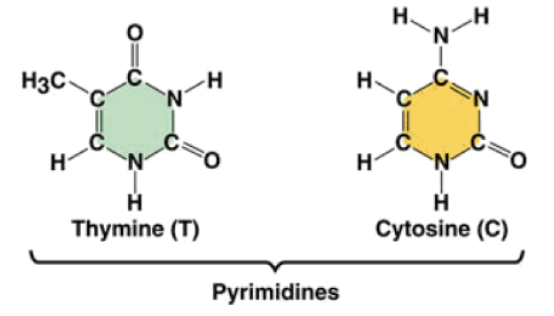Bio Unit 7.2: DNA Replication
1/26
Earn XP
Description and Tags
Name | Mastery | Learn | Test | Matching | Spaced |
|---|
No study sessions yet.
27 Terms
DNA
DeoxyriboNucleicAcid
Nucleotide structure
phosphate, pentose sugar (deoxyribose in DNA), nitrogen base

Base pairs are connected with _______ bonds and the phosphate-sugar backbone is connected with _____ bonds
hydrogen (can be easily unzipped), covalent (provides integrity)
Purine + examples
2 ring nitrogen base (adenine and guanine)

Pyrimidine + examples
1 ring nitrogen base (cytosine and thymine)

The four nitrogen bases and what they pair with
Adenine - Thymine
Cytosine - Guanine
Why can each base only go with one other base? (2)
1) Number of rings
Purine + purine = too wide
Pyrimidine + pyrimidine = too narrow
Purine + pyrimidine = perfect (2nm)
2) Number of hydrogen bonds
Bases are held together with hydrogen bonds
C-G has three hydrogen bonds
A-T has two hydrogen bonds
4 major enzymes in DNA replication
Helicase
DNA polymerase
Primase
Ligase
Helicase
unzips DNA by breaking the hydrogen bonds
DNA polymerase
builds the new strand of DNA and proofreads the strand at the end
Primase
adds primer (RNA) to the DNA strand for the polymerase to bind to and tells polymerase where to start
Ligase
glues fragments together
Steps of DNA replication (5)
Helicase unzips the enzyme
Primase adds primer
Polymerase builds on nucleotides
The DNA rezips and rewinds
Polymerase “proofreads” the DNA for mistakes
2 things that keep the DNA from winding back up while replicating
SSB proteins bind to the DNA strands to keep them separated
Topoisomerase keeps the DNA from supercoiling (overwinding of DNA)
Antiparallel
strands are parallel but they go in opposite directions
3’ and 5’- how does polymerase build?
The carbons on the sugar are numbered clockwise after the oxygen
The number at the top to the number at the bottom is the name for the direction
Polymerase can only BUILD from 5’ → 3’ but MOVES from 3’ → 5’ along the old strand

Leading strand
strand being built while moving from 3’ → 5’
Lagging strand
strand being built while moving from 5’ → 3’
Okazaki fragments
result from lagging strand having to keep jumping forward after building a chunk to get to the unraveling DNA
Semiconservative
the two copies each contain one original strand
Place of origin
where replication starts
multiple origin points
form bubbles that expand into each other
ligase glues them together
Replication speed (example and why)
Human cells can replicate a full set of chromosomes in 8 hours
there are multiple points of origin
Strand is unzipped and more nucleotides are added immediately
Chase and Hershey
Couple who discovered DNA was genetic material using bacteriophage
Bacteriophage + experiment
used radioactive isotopes to track the DNA and protein in bacteriophage
After the virus infected the bacteria, the protein was detected outside the cell and the DNA was detected inside the cell
Virus lysed the cell (caused it to explode) by “hijacking it”
Injects its own DNA into the cell so the cell produces more virus
virus burst out of cell once they are formed
Rosalind Franklin
X-rayed DNA and provided evidence it is a double helix shape
Chargaff(‘s rule)
within an organism the ratio of A:T and C:G is 1:1
Watson and Crick
put the puzzle pieces together
discovered the structure of DNA
2nm wide, double helix, purine + pyrimidine, antiparallel